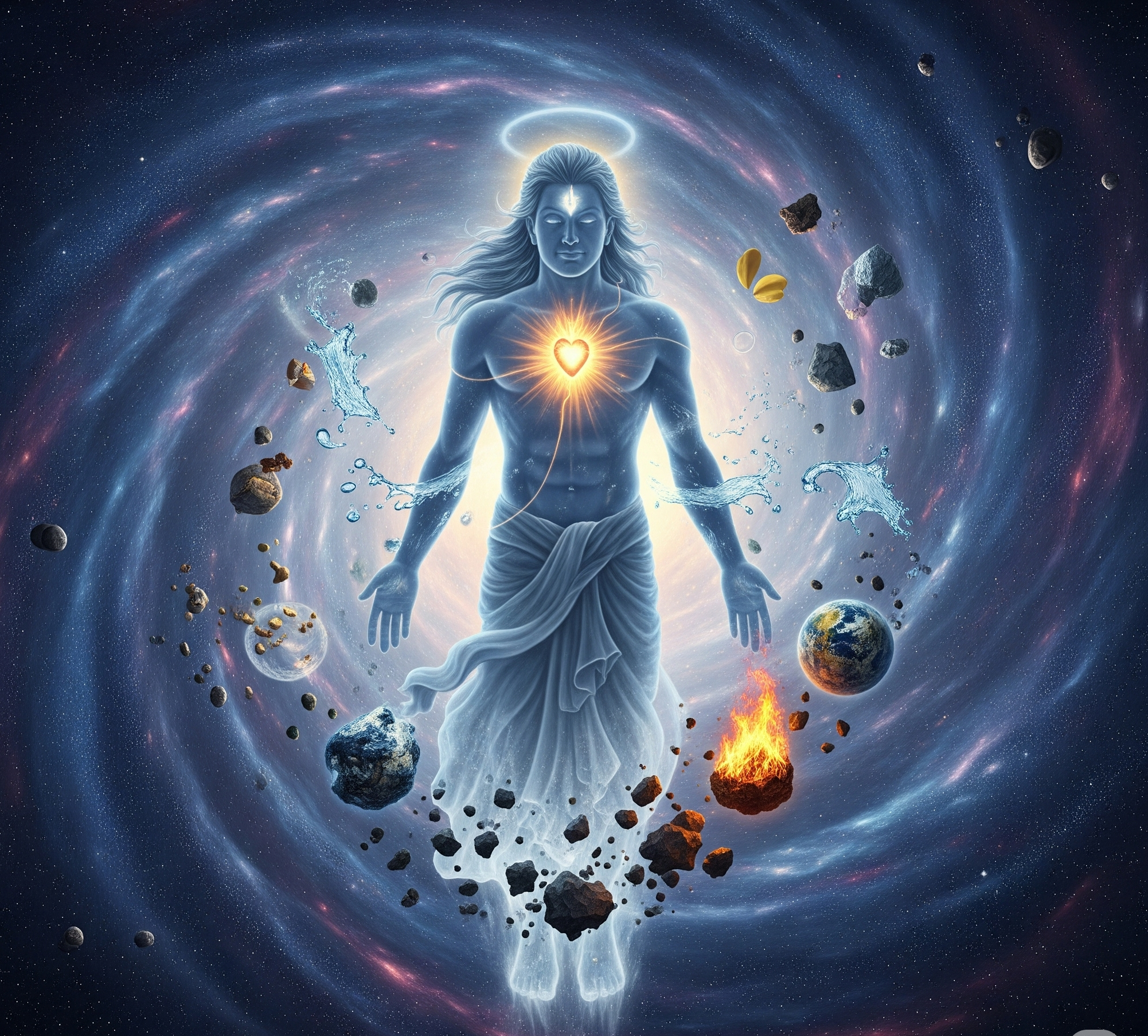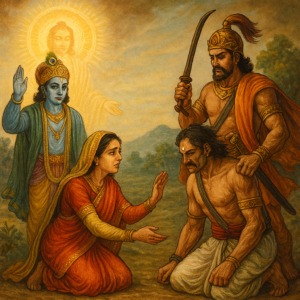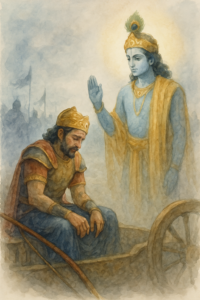Where did everything begin? What if the universe’s grand design mirrors our own struggles, desires, and purpose? Just as we navigate our own lives—choosing careers, building relationships, and shaping our destinies—the grand cosmos, too, had an architect.
Step into the pages of the Bhagavata Purana, where science meets the spiritual, and uncover the breathtaking origins of all that exists. Let’s embark on a journey through time, space, and beyond—where mythology meets reality.
King Parikshit, consumed by his quest for ultimate knowledge, turned to the wise sage Shree Sukhdevji with a profound question: “How did the universe originate from the Virat Purusha, the Cosmic Person?”
Shree Sukhdevji smiled, his gaze steady and wise. “I shall recount this cosmic story as revealed in the sacred Bhagavata Purana, a timeless narrative that explores ten profound topics: Sarg, Visarg, Sthan, Poshan, Utii, Manvantar, Ishakatha, Nirodh, Mukti, and Ashraya.”
Sukhdevji’s voice resonated as he unfolded these interconnected cosmic principles—each an essential thread in the fabric of existence. Let us understand these with detailed clarity:
- Sarg (The Primary Creation):
Sarg refers to the fundamental principles of creation brought into being by divine inspiration and transformation. It includes the Panchmahabhut (the five great elements—earth, water, fire, air, and space), Shabd (sound), Matraye (perceptions or measures of sensory experience), Indriya (the senses), Ahankar (ego), and Mahtatva (the great cosmic principle or universal intelligence). These subtle elements form the building blocks of the universe and arise from the cosmic will of the Supreme. - Visarg (Secondary Creation):
Visarg pertains to the creation of various living and non-living entities by Brahmaji. Virat Purusha, the Cosmic Being organizes these entities in diverse forms, establishing the foundation of life and the interplay of beings within the manifested universe. - Sthan (Maintenance of Creation):
The term Sthan signifies the preservation and orderly maintenance of creation. Lord Vishnu, as the preserver, ensures that the universe operates within defined limits, preventing its premature destruction. This accomplishment reflects divine care, providing stability and continuity to creation. - Poshan (Divine Grace and Protection):
Poshan refers to the divine grace and sustenance offered to devotees and beings within the protected creation. It emphasizes how Lord Vishnu nurtures and uplifts those who surrender to His will, guiding them on the path of righteousness and spiritual evolution. - Utii (Bondage Through Actions):
Utii represents the cycle of cause and effect or the bondage created by actions (karma). Beings are bound by their deeds, which shape their destiny. This concept underscores the need for conscious living and spiritual practices to transcend this bondage. - Manvantar (Epochs of Cosmic Governance):
Manvantar describes the cosmic ages ruled by humanity and guardians of dharma. During these periods, rulers practice and uphold pure dharma, ensuring the welfare of their subjects while fostering devotion to the Supreme Lord. - Ishakatha (Divine Narratives):
Ishakatha encompasses the enchanting stories of the Lord’s various incarnations (avatars) and the lives of His devoted followers. These narratives, rich in teachings and symbolism, inspire devotion and highlight the virtues of surrender, faith, and divine love. - Nirodh (Cosmic Absorption):
Nirodh signifies the absorption of the individual soul, along with its attributes and limitations, into the Supreme. When the Lord enters yogic sleep (yoganidra), the dissolution of creation occurs, merging all elements back into Him, signifying the cyclical nature of the universe. - Mukti (Liberation):
Mukti, or liberation, is the renunciation of false identification with the body, senses, and material existence. It involves realizing one’s true self as the soul and attaining freedom from the cycle of birth and death. This realization leads to eternal peace and union with the divine essence. - Ashraya (Supreme Shelter):
Ashraya is the ultimate reality and refuge from which all creation arises and into which it eventually dissolves. This Supreme Brahma, also referred to as the Supreme Soul, is the substratum of all existence and the final goal of spiritual realization.
The Virat Purusha and the Beginning of Creation
In the depths of the cosmic void, emerged the Virat Purusha, the Supreme Cosmic Person. Majestic and immeasurable, He sought a space to reside, an abode to set in motion the timeless cycle of creation. Thus, He created pure, sacred water named as Nar. Residing in this water for a thousand years, He became known as Narayan—the One who rests in Nar.
This act was not arbitrary. It was imbued with intention, purpose, and the grace of Lord Narayan, who infused existence with the essence of time, action, nature, and being. From His yogic meditation emerged the desire to multiply and create.
The Manifestation of the Elements and the Cosmos
As Narayan stirred, the five elements began to awaken—space, air, fire, water, and earth. Each element, subtle at first, became the foundation of the tangible universe. From His cosmic body emerged the senses, each corresponding to a desire that arose within Him.
- When the desire to speak emerged, the organs of speech and the sense of hearing were created. Alongside, the presiding deity of sound, Vayu (wind), appeared.
- The desire to see brought forth the eyes, accompanied by Surya (the Sun) as their presiding force.
- Hunger and thirst manifested the mouth and taste buds, while rivers and oceans formed to sustain nourishment.
- The urge to touch gave birth to the skin, creating the sensations of softness, hardness, cold, and warmth.
Each of these manifestations was not random but symbolic. They reflected how human experiences echo the microcosmic and macrocosmic unity of existence. Through this process, life began to form, from trees and rivers to animals, celestial beings, and eventually humankind.
The Seat of Thoughts and Desires
The heart of the Virat Purusha became the seat of thoughts and feelings. From it sprang the mind—full of desires, intentions, and dreams—and from the mind arose the Moon as its celestial ruler. Thoughts interwove with the subtle elements of ego and intellect, forming the bridge between the material and spiritual realms.
Shree Sukhdevji revealed that this cosmic being—manifested in both the gross and subtle forms—was a mere extension of the Supreme Lord. Beyond these manifested and unmanifested realms lay a reality so subtle, so profound, that it transcended all. It was the ultimate Ashraya, the refuge of all existence.
The Cosmic Flower and Its Subtle Nature
Shree Sukhdevji concluded by comparing the Virat Purusha to a divine cosmic flower, intricately enveloped by eight coverings: earth, water, fire, air, space, ego, intellect, and nature. Beyond these coverings lies the extremely subtle and transcendent form of the Lord, ungraspable by the ordinary mind.
These two forms—the gross, manifested universe and the subtle, unmanifested essence—are expressions of the Lord’s Maya, an illusion that veils the ultimate reality. They exist to guide creation, allowing beings to rise from illusion to enlightenment.
Through this narration, the profound wisdom of the Bhagavata Purana reveals the interconnectedness of all existence and inspires a path toward understanding the deeper realities of life and spirituality.
Unity in Diversity: All Is the Lord
“Understand this,” Shree Sukhdevji emphasized, “Every being—whether it is Prajapati, Manu, Devas, Rishis, Pitrus, or even animals, birds, and inanimate mountains and rivers—is a part of the Supreme Lord. Though veiled by Maya (illusion), all forms arise from Him and eventually return to Him.”
He further illustrated how all beings are expressions of the same cosmic energy. Whether it is the majestic Sun guiding the day or the gentle rivers sustaining life, every element is a fragment of divine intent, working in perfect harmony with the grand design.
Closing Thought: A Call for Conscious Living
The story of the Virat Purusha teaches that life is sacred and interconnected. When we see the divine spark in all things—be it nature, fellow humans, or our own actions—we foster a deeper connection with the universe. Creation was not born of randomness but of intentionality, just as our lives can become purposeful through mindfulness, compassion, and service.
The cosmic narrative serves as a mirror, reflecting that we, too, are creators in our own realms. Our choices, actions, and interactions ripple outward, shaping the world around us. Let the lesson of the Virat Purusha guide us to live consciously, nurturing the world as an extension of ourselves. In doing so, we align with the eternal truth: all is the Lord, and the Lord is all.
This story shines as a beacon in today’s world, urging us to dissolve the illusion of separation and embrace the infinite oneness of creation. It is through this realization that humanity can transcend conflict, achieve harmony, and fulfill its divine potential.



